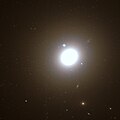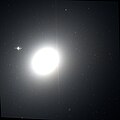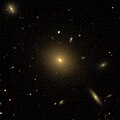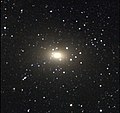
This is a list of galaxies with richest known globular cluster systems. As of 2019, the galaxy NGC 6166 has the richest globular cluster system, with 39 000 globular clusters. [1] Other galaxies with rich globular cluster systems are NGC 4874, NGC 4889, NGC 3311 and Messier 87. For comparison, the Milky Way has a poor globular cluster system, with only 150-180 globular clusters.
| Galaxy | Image | Number of globular clusters | Notes |
|---|---|---|---|
| NGC 6166 |  | 39 000 ± 2000 [1] | Richest known globular cluster system |
| NGC 4874 |  | 18 700 ± 2260 [2] | Richest globular cluster system in Coma Cluster |
| NGC 3311 |  | 16 500 ± 2000 [3] | Richest globular cluster system in southern part of the sky and in Hydra Cluster |
| Messier 87 |  | 12 000 ± 800 [4] | Richest globular cluster system in Virgo Supercluster and richest in Messier Catalog. Also richest within 100 million light-years. Data from 2006 survey |
| NGC 4889 |  | 11 000 ± 1340 [5] | Largest galaxy in this list (diameter is about 1050 000 light-years) |
| IC 4051 |  | 6700 ± 530 [5] | Richest globular cluster system in IC catalog |
| NGC 1395 |  | 6000 ± 1100 | Richest globular cluster system in Eridanus Cluster, divided into two populations (red and blue) |
| NGC 1399 |  | 6000 ± 600 | Richest globular cluster system in Fornax Cluster, most clusters are given |
| Messier 49 |  | 5900 | |
| Messier 60 |  | 5100 [6] | |
| Messier 86 |  | 3800 | Richest globular cluster system in Markarian's Chain |
| NGC 6861 |  | 3000 ± 300 [7] | |
| NGC 1600 |  | 2850 | |
| Messier 59 |  | 2200 | |
| Messier 89 |  | 2000 | Data from 2006 survey |
| Messier 84 |  | 1775 ± 150 | |
| Sombrero Galaxy |  | 1600 ± 400 | Richest globular cluster system around named galaxy |
| Centaurus A |  | 1450 ± 160 [8] | |
| NGC 4278 |  | 1378+32 −194 | |
| NGC 4926 |  | 1300 ± 300 [5] | |
| Maffei 1 |  | 1100 | Closest galaxy in this list (distance is about 11 000 000 light-years) |